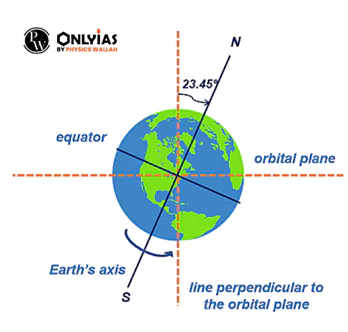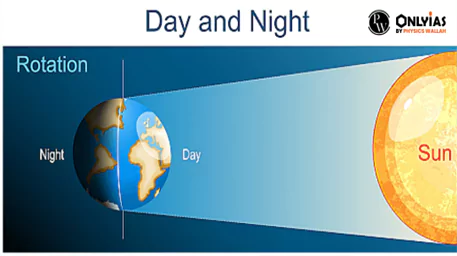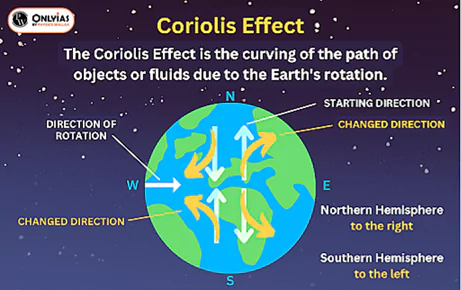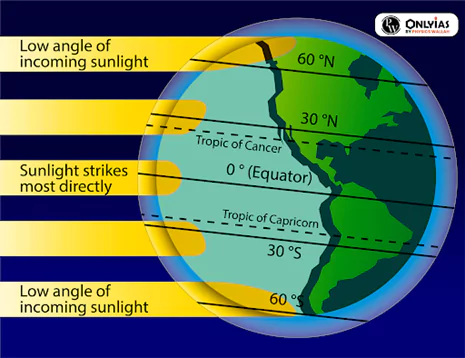Introduction: The Phenomena of the Rotation of Earth
The rotation of earth is the continuous spinning of our planet on its axis, which is an imaginary line passing through the North and South Poles. This rotation of earth is responsible for the alternation of day and night as well as the creation of Earth’s time zones. It takes approximately 24 hours for Earth to complete one full rotation, resulting in a wide range of fascinating natural phenomena and impacts on our daily lives.
Rotation of Earth and Revolution
- The Earth is in constant motion, and its movements can be categorised into several key patterns.

- These motions include rotation, which causes day and night, as well as its orbit around the Sun, responsible for our changing seasons.
- Additionally, the Earth’s axis undergoes precession, leading to long-term shifts in the alignment of the North Pole.
- Primarily two motions: Rotation and Revolution.
Rotation of Earth: Earth’s Dynamic Spin
The rotation of earth refers to the spinning of our planet around an imaginary line called its axis.
- Direction and Speed: Earth rotates from west to east, which means it turns counterclockwise when viewed from above the North Pole.
- The rotational speed varies depending on one’s location.
- At the equator, Earth’s rotational speed is approximately 1,670 kilometres per hour (1,040 miles per hour), while it decreases as you move toward the poles.
- Duration of Rotation: Earth takes approximately 23 hours, 56 minutes, and 4 seconds to complete one full rotation. This period is known as a sidereal day.
- However, to align our days with the 24-hour clock, a solar day is used, which is 24 hours long.
- The difference between a sidereal day and a solar day is due to Earth’s orbit around the Sun.
- Day and Night: The rotation of earth is responsible for the cycle of day and night.
- As one side of the Earth faces the Sun, it experiences daylight, while the opposite side is in darkness, creating nighttime.
- The boundary between these regions is called the terminator.
- Coriolis Effect: The rotation of earth gives rise to the Coriolis effect, which influences the direction of moving objects, such as winds and ocean currents.

-
- In the Northern Hemisphere, objects are deflected to the right, while in the Southern Hemisphere, they are deflected to the left.
- Celestial Sphere: The rotation of earth makes the celestial objects (stars, planets, and the Moon) move across the sky from east to west.
- This apparent motion is due to the rotation of the Earth, and it gives the impression of a rotating celestial sphere.

- Implications for Timekeeping: The rotation of earth forms the basis for the concept of time.
- A 24-hour day is divided into 24 time zones, each approximately 15 degrees of longitude wide, with the Prime Meridian (0 degrees longitude) as the reference point.
- Effects on Gravity: The rotation of earth causes a slight flattening at the poles and bulging at the equator, resulting in an oblate spheroid shape.
- The variation in gravitational strength due to this shape difference is known as the geoid.
What if the Earth Stops Rotating? – Consequences of the Rotation of Earth
If the Earth suddenly stopped rotating, it would have dramatic and catastrophic consequences.
- Permanent Day and Night: One side of the Earth would experience constant daylight, while the other would be in perpetual darkness.
- Example: The side facing the Sun would become unbearably hot, while the dark side would become incredibly cold, similar to the extreme temperatures experienced on the Moon.
- Extreme Temperature Variations: With no day-night cycle, temperature differences between the two hemispheres would be extreme.
- Example: Temperatures in the daylight zone could soar to hundreds of degrees Celsius, while the dark side would plunge to hundreds of degrees below freezing.
- Disrupted Climate and Weather Patterns: The rotation of earth influences global weather patterns and atmospheric circulation.
- Example: The absence of rotation of earth would lead to the loss of prevailing winds, causing unpredictable and violent weather phenomena, including massive storms and hurricanes.
- Tsunamis and Coastal Devastation: Oceans would continue moving, generating massive tsunamis that would inundate coastal regions.
- Example: Coastal cities and communities would face catastrophic flooding, causing extensive damage and loss of life.
- Magnetic Field Collapse: Earth’s magnetic field, generated by the planet’s core motion, is crucial for shielding us from harmful solar radiation and cosmic rays.
- Example: Without the magnetic field, Earth would be exposed to increased radiation, endangering all living organisms.
- Stagnant Atmosphere: The atmosphere, which circulates due to rotation of earth, would become stagnant.
- Example: Stagnant air masses would trap pollutants and hinder the distribution of temperature and gases, causing air quality and climate issues.
- Ecosystem Disruption: Altered temperature and weather patterns would disrupt ecosystems and lead to species extinction.
- Example: Plants and animals reliant on the day-night cycle for growth, reproduction, and behaviour would struggle to adapt, potentially facing extinction.
The Equator’s Longer Days: Earth’s Tilt and Sun’s Path
Why are days always longer than nights at the equator? – The Role of the Rotation of Earth
Days are generally longer than nights at the equator due to the axial tilt of the Earth and its relationship with the Sun.
- Earth’s Axial Tilt: The Earth’s axis is tilted at an angle of approximately 23.5 degrees relative to its orbit around the Sun.
- This tilt is responsible for the changing seasons and the varying lengths of days and nights.
- Equator’s Position: The equator is an imaginary line that lies exactly halfway between the North and South Poles.
- Because the equator is positioned at a right angle to the Earth’s axis, it remains parallel to the plane of Earth’s orbit around the Sun.

- Sun’s Apparent Path: Due to Earth’s axial tilt and the equator’s location, the Sun appears to move directly above the equator twice a year during the equinoxes (around March 20th and September 22nd).
- During these times, the Sun is almost directly overhead at noon, and the day and night are roughly of equal length.
- Changing Day Length: As the Earth orbits the Sun, the angle at which sunlight reaches different parts of the Earth’s surface changes.
- This results in varying day lengths throughout the year.
- Near the equator, the Sun’s rays remain relatively perpendicular to the Earth’s surface for most of the year, resulting in longer daylight hours.
- This is why, at the equator, days are generally longer than nights.
- Seasonal Variation: While the equator experiences relatively consistent day lengths, regions farther from the equator have more pronounced variations between day and night length as the seasons change.
- Near the poles, there are periods of continuous daylight during summer and continuous darkness during winter.
| Previous Year Questions
Q.1) In the northern hemisphere, the longest day of the year normally occurs in the: (2021)
Ans: b Q. 2) Variations in the length of daytime and night time from season to season are due to: (2013) (a) The rotation of earth on its axis (b) The earth’s revolution around the sun in an elliptical manner (c) Latitudinal position of the place (d) Revolution of the earth on a tilted axis Ans: a Q.3) On 21st June, the Sun (2019)
Ans: a |






























